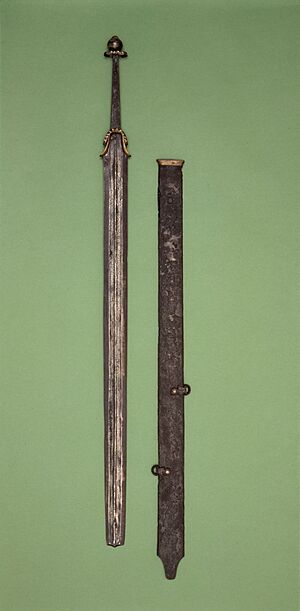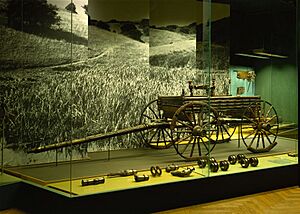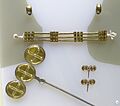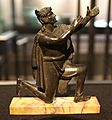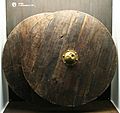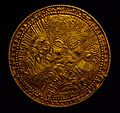Archaeology of Northern Europe facts for kids

The archaeology of Northern Europe is all about studying the very old history of places like Sweden, Norway, Denmark, northern Germany, Poland, and the Netherlands. It looks at how people lived there long before written records.
This region entered the Mesolithic period (Middle Stone Age) around 7000 BC. People started farming and building big stone monuments during the Neolithic (New Stone Age), marked by the Funnelbeaker culture around 4000 BC. Later, the Copper Age saw the arrival of the Corded Ware culture. This might have been when early Indo-European languages first spread to the area. The true Nordic Bronze Age began about 1500 BC. As the Bronze Age ended, people in Northern Europe started connecting with the La Tène culture (Celts) from Central Europe. This led to the start of the Iron Age around 400 BC, which is thought to be where the Common Germanic culture began. Northern Europe started its "protohistorical" period (when some writing appeared, but not full history) in the early centuries AD, as Roman writers started describing the Germanic peoples.
Contents
How We Divide Time in Northern Europe's Past
Archaeologists divide the long history of Northern Europe into different periods. This helps us understand the changes over time, from the Stone Age to more recent times.
| Stone Age (Up to 1500 BC) |
Palaeolithic (Old Stone Age) | Up to 8000 BC |
| Mesolithic (Middle Stone Age) | 8000 to 3000 BC | |
| Neolithic (New Stone Age) | 3000 to 1750 BC | |
| Bronze Age | 1750 to 500 BC | |
| Iron Age (500 BC to 800 AD) |
Pre-Roman Iron Age | 500 BC to 1 AD |
| Roman Iron Age | 1 to 400 AD | |
| Germanic Iron Age | 400 to 800 AD | |
| Viking Age | 800 to 1066 AD | |
| Medieval Period | 1066 to 1500 AD | |
The Stone Age in Northern Europe
Around 6000 BC, the climate in Scandinavia was warmer and wetter than it is today. People from cultures like the Kongemose culture were hunter-gatherers. They hunted animals and gathered plants for food. Later, the Ertebølle culture took over. These people slowly started to farm and build large stone tombs called megaliths. This change led to the Funnelbeaker culture.
Early Pottery and New Cultures
Some of the earliest pottery in Northern Europe, called "comb ware," appeared around 4200 BC. It continued to be used until about 2000 BC. Some experts think this pottery is linked to people who spoke Uralic languages.
During the 3000s BC, the Funnelbeaker culture spread into Sweden. Other cultures like the Pitted Ware culture also developed. Around 3000 BC, early Indo-European groups likely arrived, bringing with them cultures like the Corded Ware culture. These groups later influenced the start of the Nordic Bronze Age.
The Bronze Age
The Bronze Age in Northern Europe lasted from about 1750 BC to 500 BC. During this time, people learned to make tools and weapons from bronze, a mix of copper and tin. Bronze was very important because it was stronger than stone.
The Iron Age in Northern Europe
The Iron Age in Northern Europe is split into three main parts: the Pre-Roman Iron Age, the Roman Iron Age, and the Germanic Iron Age. This way of dividing time was first suggested by a Swedish archaeologist named Oscar Montelius.
The Pre-Roman Iron Age (500 BC - 1 AD)
This was the first part of the Iron Age in Scandinavia and the northern European plains. It followed the Nordic Bronze Age. People in this area started using iron because they learned techniques from the Hallstatt culture in Central Europe.
Archaeologists realized that some Iron Age items found on the island of Bornholm didn't show much Roman influence. This meant that parts of Northern Europe hadn't yet connected with the Romans when the Iron Age began there.
Iron became more common because bronze, which had to be imported, became very hard to find. Iron, however, could be found locally, often in bog iron from wet areas. The first iron items made were needles and tools like swords and sickles. It took a while for iron-working skills to spread, but by 200-100 BC, people in larger settlements were good at making iron products.
People continued to burn their dead and put the ashes in urns, just like in the Bronze Age. We have found many items from this time, like swords, spearheads, scissors, and knives. Bronze was still used for decorations, but it was much rarer. Some famous finds from this period include the Gundestrup cauldron and the Dejbjerg wagons.
The end of the Nordic Bronze Age and the start of the Iron Age also saw changes in the climate. This led to a big shift in plants and animals. It's debated whether new ideas spread because people moved south (a "demic diffusion") or through peaceful trade and sharing of ideas (a "trans-cultural diffusion"). Today, many think that the changes in the Iron Age happened more from local development rather than large groups of people moving in.
The people living in Northern Europe during this Iron Age were likely speakers of early Germanic languages. Towards the end of this period, groups like the Teutons and Cimbri began to move, leading to more changes in the Roman Iron Age.
The Roman Iron Age (1 - 400 AD)
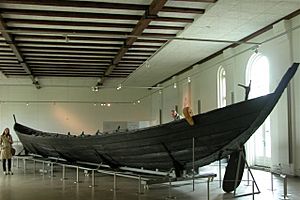
This period gets its name because the powerful Roman Empire started to influence the Germanic tribes in Northern Europe. Many goods were imported from the Roman Empire, such as coins, fancy vessels, bronze statues, and glass cups. The style of metal objects and clay pots also became very Roman. New items like scissors appeared for the first time.
From the 200s and 300s AD, some ideas came from Germanic tribes living near the Black Sea, including the use of runes (an early form of writing).
Many bog bodies (well-preserved bodies found in peat bogs) have been discovered from this time in Denmark and southern Sweden. Along with the bodies, archaeologists have found weapons, household items, and clothes made of wool. While cremation was common, burying bodies whole became more popular after the 200s AD. Large ships built for rowing have been found from the 300s AD in Nydam Mose in southern Denmark.
Important places like the Gudme Hall complex in Denmark (a home for powerful leaders and a religious site) were built in the 200s AD. In Norway, a large hall for a chief was built at Borg around 500 AD. In Sweden, the biggest Iron Age settlement, Upkåkra, grew from about 200 AD. A wooden temple was built at Uppåkra in the 200s AD and was used and rebuilt for over 600 years, even into the early Viking Age.
During the 400s and 500s AD, gold and silver became much more common. This was a time when Germanic tribes attacked the Roman Empire, and many Scandinavians returned home with gold and silver. This wealth marked the beginning of a new period: the Germanic Iron Age.
The Germanic Iron Age (400 - 800 AD)
The Germanic Iron Age is divided into an Early and a Late period. In Sweden, the Late Germanic Iron Age (550–800 AD) is called the Vendel era. In Norway and Finland, it's known as the Merovingian Age.
This period began after the Roman Empire fell and new Germanic kingdoms rose in Western Europe. In Northern Europe, it was followed by the famous Viking Age.
During the time the Roman Empire was weakening, a lot of gold flowed into Scandinavia. Many beautiful gold items were made then, like sword decorations and special gold pendants called bracteates.
After the Western Roman Empire collapsed, gold became harder to find. So, Scandinavians started making objects from bronze covered in gold, often with detailed animal designs. In the early part of this age, the animal designs were simpler. Later, they became more complex and abstract, with animals whose bodies and limbs were twisted together in patterns.
The Late Germanic Iron Age, especially in the 700s AD, slowly blended into the Viking Age. This was a time when stories and legends were passed down by word of mouth. These stories were later written down in books like the Gesta Danorum and in sagas. We also start to see early written records in the form of runestones.
-
Model of an Alemannic village at Ellwangen, Germany, 7th century
See also
- Archaeology of Denmark
- List of archaeological periods
- Prehistoric Europe
- Ringwall (German wiki)


